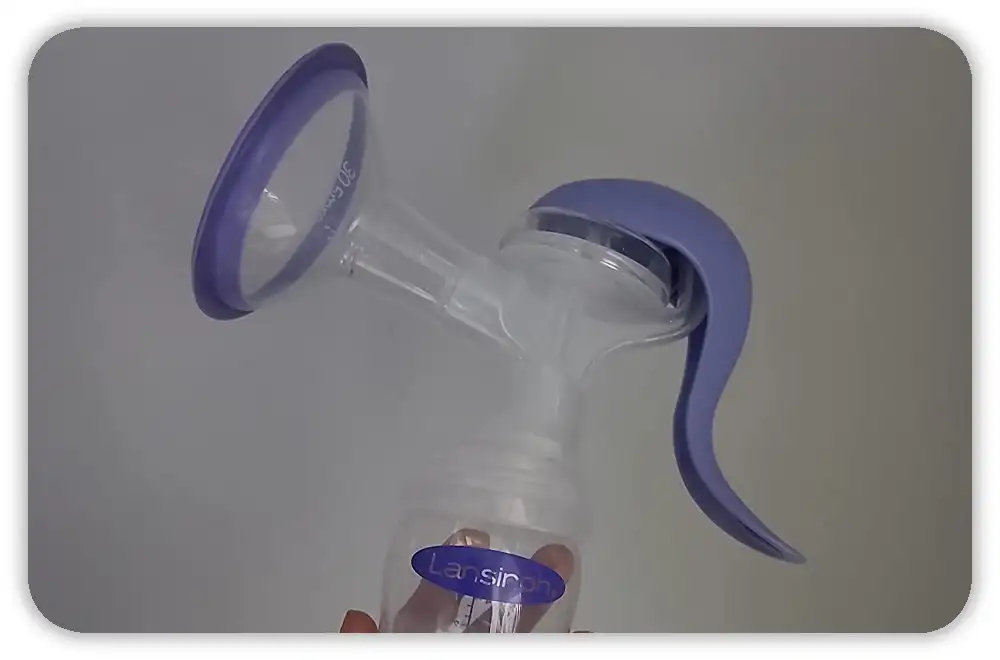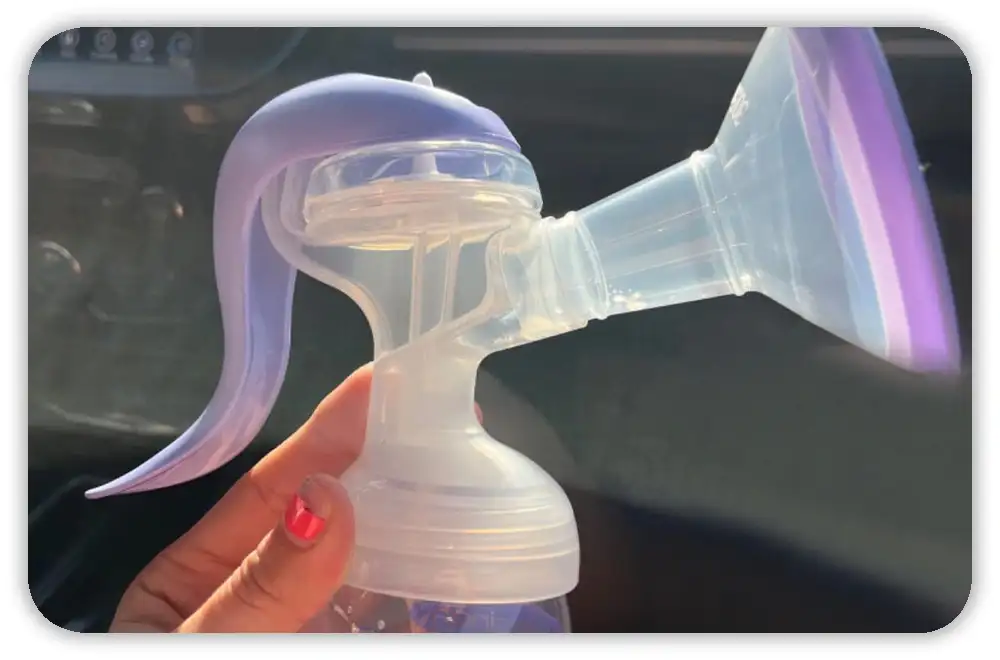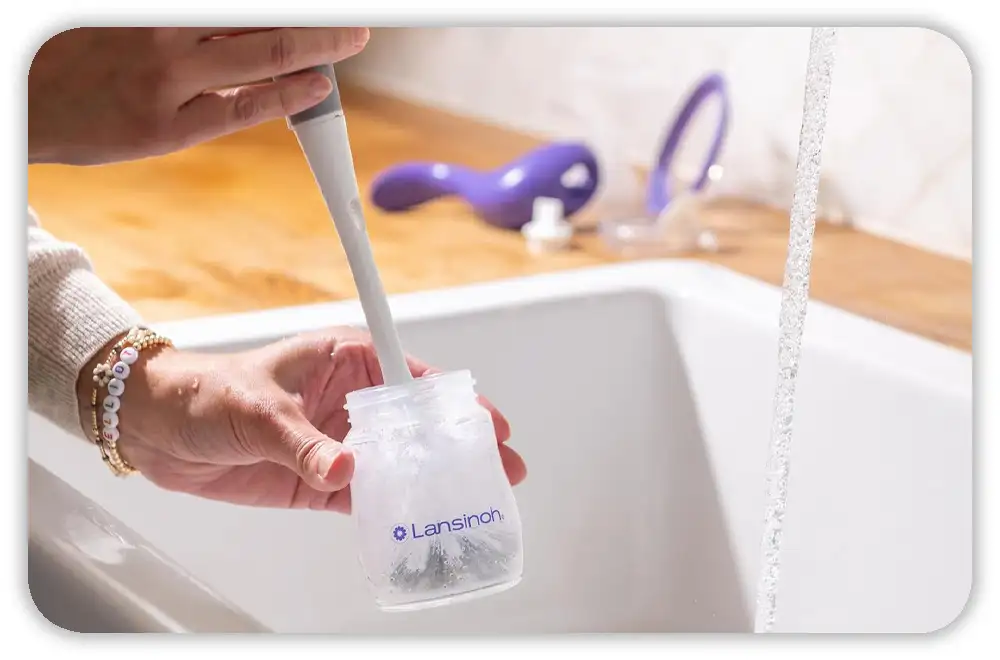Uh-oh, is your Lansinoh manual breast pump not suctioning like it should?
Here’s the quick fix: it’s usually a simple issue with the white valve, flange fit, or diaphragm seal — and yes, you can fix it at home in minutes.
As a mom who’s been in the trenches of late-night pumping, I know how frustrating this can be.
I’ve tested, researched, and repaired this pump more times than I can count — and I’m here to walk you through it step-by-step.
Keep reading and let’s get your pump working today — no stress, no mystery.
Table of Contents
Fast Fix First: The 20-Second Thumb Test
Let’s start with the fastest way to check why your Lansinoh manual pump isn’t suctioning. I call it the Thumb Test — no tools, no stress. It takes just 20 seconds.
How to Do the Thumb Test:
- Take your pump apart.
- Rebuild it with only three parts:
- the pump body
- the silicone diaphragm with stem
- the handle
- Leave off the valve, bottle, and flange.
- Cover the bottom hole (where the bottle would screw in) with your thumb.
- Squeeze the handle a few times.
What You Should Feel:
- Strong suction on your thumb?
Great! That means the pump’s core parts — the diaphragm and handle — are working. - No suction at all?
Something’s off. The diaphragm may be loose, torn, or not sealed right.
What to Do Next (Based on Your Result):
If suction is strong: The problem is further down. Likely the white valve, flange fit, or maybe some trapped moisture.
→ Skip ahead to Section IV to check those parts.
If there’s no suction: The issue is in the pump’s “engine.” That means the diaphragm may need a reset.
→ Go to Section IV.1 and follow the diaphragm fix.
I remember trying this at 2 AM, eyes half shut, hoping for a miracle. When I felt that tiny pull on my thumb — I nearly cried with relief. It was the moment I knew I could fix it.
Why Your Lansinoh Manual Pump May Stop Suctioning
If your Lansinoh manual pump isn’t suctioning, don’t panic. It’s usually one of these small, fixable things.

I’ve hit every one of these problems — usually at 3 a.m., half-awake. Good news? Most are super easy to fix.
Diaphragm Isn’t Sealed Right
This is the most common issue. If the silicone diaphragm isn’t snug, you lose suction. Even a small gap can break the seal.
White Valve Is Missing or Torn
That soft white flap under the flange matters more than it looks. If it’s ripped, loose, or gone — no suction at all. I once dropped mine in the garbage disposal. Total mess.
Flange Fit or Seal Is Off
Your flange needs to fit well and sit flat on your skin. If it’s too small, too big, or not sealed — air sneaks in. That breaks the vacuum and stops the flow. Yes, size really does matter here.
Handle Isn’t Clicked In
If the handle feels loose or floppy, check the latch. A weak click means weak suction. Push it in until it locks firmly.
Parts Are Wet
Water ruins suction. Even a tiny drop in the valve or diaphragm can break the seal. After washing, let everything air-dry fully. I now dry all parts overnight — no towels, no guessing.
Silicone Parts Are Worn Out
Soft silicone can wear out over time. If your valve or diaphragm looks cloudy, floppy, or cracked — replace it. Fresh parts can make a huge difference.
How to Fix a Lansinoh Manual Pump That’s Not Suctioning
Alright, mama — if the thumb test showed weak or no suction, or you’ve ruled out the usual stuff, it’s time to get hands-on.
These fixes are quick. No tools needed. I’ve done every one of these in a bathrobe, half-asleep. You’ve got this.
Reseat the Silicone Diaphragm
This small part is the pump’s heart. Each time you squeeze, it creates suction. If it’s not seated just right, your pump won’t work — even if everything else looks perfect.
Most Common Mistake: The diaphragm isn’t sealed all the way around. Even a tiny gap lets air in — and kills suction.
How to Fix It:
- Take the diaphragm out.
- Let it air-dry — no towel (towels leave lint).
- Press it into place slowly, working around the rim in a circle.
- Tug gently on the center stem. It should bounce back smoothly.
Inspect and Replace the White Valve
This floppy white piece under the flange is tiny — but powerful.
It helps create the vacuum you need.
What to Look For:
- Torn edges
- Stretched or floppy silicone
- Missing valve (they disappear during washing!)
Need a new one?
Order replacement valves on Amazon or Lansinoh’s website.
I always keep extras in my bag — they’re easy to lose.
Quick test:
With the valve on, turn the pump upside down. If the flap hangs open or won’t seal, swap it out.
Fix a Loose or Disconnected Handle
No suction?
Your handle might not be clicked in all the way. This happens a lot after cleaning.
What to Check:
- Handle should snap into the hinge on the diaphragm
- If it feels loose, remove it and reattach
- Squeeze it — it should bounce back with light resistance
Did You Know?
Your pump has two modes:
- Short, fast squeezes (let-down mode)
- Longer, deeper squeezes (expression mode)
Switch between them to mimic baby’s nursing pattern.
It helps with milk flow!
Fix the Flange Fit and Seal
The flange is the cone-shaped piece that goes over your breast. If it doesn’t fit right, suction drops fast.
Why It Matters:
- Too small? It pinches.
- Too big? It pulls in too much areola.
- Not flat against skin? Air sneaks in.
How to Get a Good Fit:
- Use Lansinoh’s free flange sizing guide
- Measure your nipple, not the areola
- Match your size to their chart
Make Sure All Parts Are Fully Dry
Moisture = leaks.
Even a drop of water in the diaphragm or valve can stop suction.
Best Drying Tips:
- Always air-dry — no towels
- Use a clean drying rack
- Let parts sit overnight if needed
I learned this the hard way. I once rushed reassembly with damp parts. The pump felt dead. It wasn’t broken — just one tiny water droplet messing it all up.
When to Replace Lansinoh Pump Parts
Here’s the truth: even if you’re super gentle with your pump, some parts wear out. And when they do, suction drops — sometimes overnight.

I didn’t know this at first. I cleaned and reassembled over and over, still wondering why it wouldn’t work. Turns out, my white valve had stretched. And the diaphragm? Worn out.
So here’s your cheat sheet for when to swap parts — and how to keep your pump working right.
How Often Should You Replace Pump Parts?
| Part | Replace Every… | Why It Matters |
| White Valve | Every 4–6 weeks (if used often) | Gets soft, loses shape, ruins suction |
| Silicone Diaphragm | Every 3–6 months | Can tear, warp, or stop flexing well |
| Flange | Every 6–12 months | Can crack or stop sealing tightly |
| Bottle Connector | As needed | Check for cracks after drops |
| Handle | Rarely | Only replace if loose or broken |
If you pump often or sterilize daily, parts may wear out faster.
Signs Your Parts Need Replacing
Here’s what to watch for — and what I wish I’d noticed sooner:
- White valve feels weak or doesn’t “snap” shut
- Diaphragm looks cloudy, stretched, or doesn’t spring back
- Flange has small cracks or feels loose when pumping
- Any part feels soft, sticky, or smells odd (yep — toss it!)
If something feels off, trust your gut. Fresh silicone often fixes the problem fast.
Where to Buy Genuine Lansinoh Replacements
Skip the off-brand kits — they often don’t fit quite right.
Here’s where I’ve bought real parts:
- Lansinoh.com – Always genuine, ships fast
- Amazon – Search “Lansinoh replacement valve” or “Lansinoh diaphragm” (read reviews!)
- Target or Walmart – Some stores stock kits in the baby aisle
About the Diaphragm
Real talk — Lansinoh no longer sells the diaphragm by itself. You have to buy a whole new manual pump kit to get one.
Frustrating? Yes.
But here’s how I make mine last:
- Let it air-dry fully — no towels or wiping
- Avoid harsh soap or boiling water
- Don’t pull too hard on the center stem when reassembling
Using those steps, I’ve kept mine working strong for over six months.
Still Not Working? Here’s When to Contact Lansinoh
Okay, so you’ve done the thumb test. You’ve checked the diaphragm, valve, handle, and flange.
But your Lansinoh manual pump still isn’t suctioning?
Don’t stress. At this point, it might be time to contact Lansinoh support.
When to Escalate
If you’ve:
- Reseated the diaphragm correctly
- Tried a new white valve
- Dried all parts completely
…and the pump still won’t pull suction —
Then it’s likely not something you can fix at home.
It could be a small crack or a rare factory defect.
What to Have Ready Before You Call
Save time (and skip a second call) by gathering this info first:
- Model name — printed on the pump or in the manual
- Purchase date and store — online stores count!
- Photos or video — if you can show what’s wrong
- List of what you’ve tried — mention the thumb test to show you’ve done the basics
How to Reach Lansinoh Support
You can contact them here:
- Website: lansinoh.com/pages/contact-us
- Phone: 1-800-292-4794 (Mon–Fri, 9am–4pm ET)
- Email: customerservice@lansinoh.com
They’re actually pretty fast to reply.
I once emailed late at night — and got a helpful answer by morning.
Real-Mom Tips for Better Pumping Results
Okay, so your pump is working again — hooray! Now let’s make pumping easier, faster, and more comfortable.

These are the tips I wish someone had told me when I was pumping at 3 a.m. One hand on the pump, the other bouncing a crying baby.
Switch Between Let-Down and Expression
Your manual pump doesn’t have buttons — you control the rhythm.
- Start with short, fast squeezes to trigger a let-down
- Once milk flows, switch to slow, deep squeezes to empty fully
What I do: I pump fast for about 30 seconds, then slow it down. It mimics baby’s nursing pattern — and works better than random squeezing.
Try Hands-On Compression
Your hands can help you pump more milk, faster.
- Gently press or massage your breast while pumping
- Use the heel of your palm near your chest
- Move your hand forward in slow, firm strokes
This helps push milk from the ducts and keeps flow steady. When I started doing this, I cut my pump time in half.
Use Nipple-Safe Lube
If pumping feels sticky or sore, try a little lube.
- Use coconut oil or a pump-safe spray
- It helps your nipple glide and reduces pain
Make sure it’s food-safe and baby-safe before using.
Keep Spares in Your Pump Bag
You don’t need a full backup kit — just a few key items:
- 1–2 extra white valves
- One clean flange (your size)
- A spare diaphragm (if you have one)
- A burp cloth or breast pad for quick cleanups
I store mine in a zip bag inside my pump pouch. It has saved me more times than I can count.
Track When You Change Parts
I used to forget when I last swapped parts. Then I’d wonder why suction felt weak again.
Now I do one of these:
- Write the swap date on a sticky note in my pump bag
- Set a phone reminder every 4–6 weeks
- Add a dot with Sharpie to mark the rotation
Final Thoughts: You’ve Got This, Mama
I know how tough it is when your pump suddenly stops. Especially at 2 a.m. You’re running on two hours of sleep and a granola bar.
But here’s the good news: Most suction problems are simple — and easy to fix.
If you’ve made it this far, you’ve probably:
- Tried the thumb test
- Checked the valve
- Reseated the diaphragm
- Dried everything (maybe twice)
If it’s working again?
Big high five from me to you.
If it’s still not?
You’re still doing great. You’re showing up, trying, and doing your best for your baby.
And that? That’s more than enough.
You don’t have to be a pump expert.
(Though after today, you might be one! )
Got questions? Drop a comment below.
Want a printable checklist? Click here — it’s free.
Know another pumping mama? Share this guide.
It might save her from a midnight meltdown.
FAQs: Lansinoh Manual Breast Pump Not Suctioning
Why is my Lansinoh manual breast pump not suctioning at all?
It’s likely a seal issue. Check the silicone diaphragm and white valve. If either one is loose, wet, or damaged, the pump won’t work.
How do I fix weak suction in my Lansinoh manual pump?
Start by reseating the diaphragm. Then check the white valve. Make sure all parts are dry — even a tiny drop of water can break the seal.
Can a worn-out white valve cause my pump to stop working?
Yes. If the valve is torn or stretched, suction will fail. Replace it every 4–6 weeks for best results.
Do I need a specific flange size for my Lansinoh manual pump?
Yes. A poor flange fit lets air in, which ruins suction. Use Lansinoh’s sizing guide to find the right fit for better flow.
What if I’ve tried everything and it’s still not working?
Contact Lansinoh support. Have your model name and purchase info ready. Mention the thumb test — it shows you’ve already tried the basics.

